Introduction
Online shopping in emerging markets in developing countries has experienced a recent surge, with a notable growth in the number of online shopping platforms and the accessibility of international brands (Sarwar et al., 2024). The internet is emerging as a prominent shopping platform, and experiencing substantial growth in comparison to traditional buying methods (Cavazos-Arroyo and Máynez-Guaderrama, 2022; Husain et al., 2022; Kumar et al., 2021). Online shopping has become increasingly popular in recent years due to its competitive pricing, wide range of products, convenience, time efficiency, ability to access customer reviews, and availability of rare items. This phenomenon has generated significant interest among researchers and marketers who seek to gain a deeper understanding of the determinants that impact consumers’ online buying behaviors (Chetioui et al., 2021). The expansion of e-commerce has also led to the emergence of impulsive buying (IB) in the context of online buying (Akram et al., 2018). IB is characterized by unplanned and rapid purchasing behavior driven by certain emotional states such as delight, desire, or other strong urges to buy (Badgaiyan et al., 2016). Consumers engage in impulsive buying online than shopping in physical stores because consumers are not burdened by inconvenient shop locations, limited working hours, and the time required to make decisions (Chan et al., 2017; Liu et al., 2019). With online shopping, they can acquire items with just a single click. Park and Yoon (2017) found that consumers engage in purchasing for several reasons beyond practical purposes, such as seeking alleviation, pursuing enjoyment, and expressing their self-image or identity.
The goal of marketers is to expand their online business by transforming customers into users who make more regular and consistent purchases (Lazim et al., 2020). Moreover, customer satisfaction and loyalty are essential factors influencing sales, including the impulsive buying behavior of customers (Lin et al., 2023). Although the internet enables consumers to access a wide variety of products and services, it can lead to post-purchase cognitive dissonance (Chetioui and El Bouzidi, 2023). Customers experience post-purchase discomfort when their initial expectations do not meet the actual performance of the goods (Chetioui and El Bouzidi, 2023; Imam, 2013). This might potentially lead to an increased number of complaints, and may even result in adverse consequences for particular brands, such as the dissemination of negative word-of-mouth, cautioning others, brand switching, or even legal action against the corporation (Lazim et al., 2020). Lake (2009) argued that cognitive dissonance could be expressed as regret or buyer’s remorse. Customers experience regret when they believe that their purchasing choices were incorrect (Gabler et al., 2017). When consumers experience cognitive dissonance and are unable to find any justifications for their decision, they may unknowingly resort to the fundamental attribution error, and attribute the fault to the company that provides the product (Robbins and Judge, 2009).
Although there have been extensive studies on online shopping perceptions and trends in developed nations, there is a lack of research on this subject in the emerging markets (Chetioui and El Bouzidi, 2023). Although researchers focused largely on studying the effects of website characteristics on IB, they ignored investigating how customers feel after purchasing (Chen et al., 2023). Furthermore, Lavuri and Thaichon (2023) examined how impulsive buying tendency (IBT) acts as a mediator between extrinsic factors and compulsive buying. They also suggest the need for additional research on personality factors, psychological factors, visual merchandising factors, and impulsive buying behavior. Additionally, Singh et al. (2023) recommended studying the impact of promotion, and firm-related factors on IB behavior in future research. This gap motivates this study to develop an integrated model to examine the effect of internal stimuli (fear of missing out (FOMO), and social media addiction), and external stimuli (promotional activities, and online visual merchandising) on online impulse buying behavior. Furthermore, this study aims to investigate the relationship between online impulsive buying behavior and post-purchase cognitive dissonance among online customers in the Egyptian market.
Theoretical Framework
Impulsive buying (IB)
Consumers exhibit impulsive buying when they unintentionally acquire something without deliberate thought or planning (Serfas et al., 2014). Moreover, spontaneous and unforeseen purchases are often accompanied with cognitive and emotional responses (Rook, 1987). There are numerous factors influencing IB. The four main elements that significantly contribute to IB are exterior cues, internal stimuli, situational and product-related factors, and demographic and socio-cultural factors (Muruganantham and Bhakat, 2013). External stimuli refer to marketing activities employed by marketers to attract customers and encourage them to make a purchase (Yoon and Faber, 2000). On the other hand, internal stimuli are aspects of an individual’s personality (Luo et al., 2018).
The impulsive buying theory primarily addresses the factors that motivate buyers to make impulsive purchases. According to the theory, which was initially put forth by Stern (1962), a number of outside factors might influence and even encourage people to make IB. Additionally, the theory claims that there is no one factor that determines whether or not consumers engage in IB behavior; rather, there are a variety of circumstances and events that might cause individuals to make purchases on the spur of the moment (Naeem, 2021). It also highlighted that marketers employ various promotional incentives that might enhance customer involvement, perhaps resulting in purchases exceeding their initial intentions (Dutta and Mandal, 2018; Iyer et al., 2020). As noted by Dutta and Mandal (2018), both Maslow’s need theory and McGregor’s motivation theory assumed that customers make well-considered purchases; however, impulsive buying theory challenges this premise (Chetioui and El Bouzidi, 2023).
Internal drivers of online impulsive buying behavior
Fear of missing out (FOMO)
Przybylski et al. (2013) defined the fear of missing out as a persistent anxiety that others may be enjoying fulfilling experiences from which one is excluded. The fundamental idea is that consumers experience psychological distress when they are socially isolated. As a result, they have an overwhelming need to conform to the actions of others to alleviate that worry (Elhai et al., 2016). Psychologists typically regard FOMO as an enduring psychological phenomenon that is unaffected by specific contextual factors (Good and Hyman, 2020). However, advertisers have extensively utilized it by employing commercial FOMO-laden appeals, which aim to encourage customers to buy products (Hodkinson, 2016). The feeling of “missing out” can significantly influence a person’s decision to make a purchase while shopping online (Abel et al., 2016; Chetioui and El Bouzidi, 2023; Good and Hyman, 2020; Good and Hyman, 2021). Consumers may overcome their initial reluctance and hesitancy by taking direct action, leading to immediate and impulsive purchases (Hodkinson, 2019). Based on the aforementioned studies, the present study proposes the following hypothesis:
H1: FOMO is positively related to online impulsive buying behavior.
Social media addiction
According to Shaffer et al. (2004), frequent exposure to an activity or drug that has addictive properties can raise the chances of developing an addiction to that particular activity or substance. Engaging in extensive social media usage heightens the likelihood of encountering advertisements and brand-related content, which further increases the chances of interacting with preferred brands or making purchases of brands and items (Nikolinakou et al., 2024). According to Shaffer et al. (2004), addiction can be understood as a syndrome resulting from a common psychological and neurobiological mechanism that manifests in various addictive behaviors such as alcohol, gaming, gambling, and social media addiction. Indications of an addiction syndrome suggest that individuals are more likely to persist in addictive behaviors and also to establish and sustain additional addictive behaviors concurrently (Nikolinakou et al., 2024). Individuals who have a strong dependence on social media may be additionally stimulated by businesses and advertisements on social media platforms, leading to the development of an impulsive shopping addiction (Mundel et al., 2023; Nikolinakou et al., 2024). Therefore, this study proposes the following hypothesis:
H2: Social media addiction is positively related to online impulsive buying behavior.
External drivers of online impulsive buying behavior
Promotional activities
According to Haugh (1983), a promotion is a strategy to boost sales by enticing customers to buy a product through discount or added value. The attractiveness of a sale makes people more likely to buy an item they don’t actually need because it seems like a good deal (Zhao et al., 2022). Moreover, online stores used sales and other promotional offers (e.g., buy-one-get-one-free, lowering prices, providing free shipping, price reductions on new products, making payments easy (digital)) as a common tactic to attract customers and encourage them to purchase online (Dawson and Kim, 2010; Gordon-Hecker et al., 2020; Luo et al., 2021; Verma and Singh, 2019). Previous studies found a significant positive relationship between sales promotion and online IB (Goel et al., 2022; Hasim et al., 2018; Longdong and Pangemanan, 2015; Zhao et al., 2022). As noted by Parsad et al. (2021), shopper impulsivity was significantly affected by loyalty programs, discounts, and rebates. This is supported by Lavuri and Thaichon (2023) who argued that effective promotion tactics are more likely to encourage customers to make impulsive purchases compared to strategies that do not have such programs. Consequently, this study hypothesizes that:
H3: Promotional activities are positively related to online impulsive buying behavior.
Online Visual Merchandising
The process of displaying visual merchandise on websites is known as online visual merchandising (Ha et al., 2007), which involves the way of product presentation, the atmosphere and visual appeal of a website (Le, 2018). A study conducted by Saini et al. (2015) has shown that the enjoyment derived from the ambiance of a store leads to an increased duration of time spent in the store, which in turn results in impulsive spending. Bastow-Shoop et al. (1991), Le (2018), and Zhao et al. (2022) argued that online visual merchandising aims to achieve the same objectives as in-store visual merchandising: to captivate customers, provide an enjoyable experience, and stimulate purchases. In other words, a visually appealing website enhances the likelihood of user engagement, and increases customer intent to acquire things (Zhao et al., 2022). Moreover, previous research on online shopping indicated that aesthetically pleasing websites are associated positively with IB (Liu et al., 2013; Wells et al., 2011). This is supported by Lazim et al. (2020) and Le (2018), who argued that online visual merchandising has a positive effect on online IB behavior. Hence, this study hypothesizes that:
H4: Online visual merchandising is positively related to online impulsive buying behavior.
Online impulsive buying behavior and post-purchase Cognitive dissonance
Cognitive dissonance, in the context of consumer behavior, is defined by Festinger (1957) as a state in which a person’s beliefs and behaviors are in conflict, resulting in a feeling of tension and discomfort. This discomfort can be alleviated by either creating a new dissonance, eliminating the existing one, or diminishing the significance of the conflicting cognition. An example of cognitive dissonance often arises in the routine buying choices made by individuals. Consumers commonly believe that they make sound decisions. However, when they impulsively acquire a product or service, it can contradict their previous confidence in their decision-making skills, leading to a sense of discomfort after the purchase (Sameeni et al., 2022). Moreover, the majority of consumers consider that the sellers have affected their cognitive consistency through their marketing activities (Cummings and Venkatesan, 1976; Elliot and Devine, 1994). Chetioui and El Bouzidi (2023) argued that people are more prone to feel psychological distress when they engage in IB. Lim et al. (2017) and Wood (1998) investigated the influence of IB on post-purchase dissonance, and found that a significant proportion of participants are likely to feel regret and anger after making purchases. In addition, George and Yaoyuneyong (2010) and Imam (2013) suggested that impulse buying results in greater cognitive dissonance compared to purchases that are more well planned. Therefore, this study proposes the following hypothesis:
H5: Online impulsive buying behavior is positively related to post-purchase cognitive dissonance.
Conceptual framework
This theoretical model is designed to better understand the relationships of the variables in this study. (see Fig. 1)
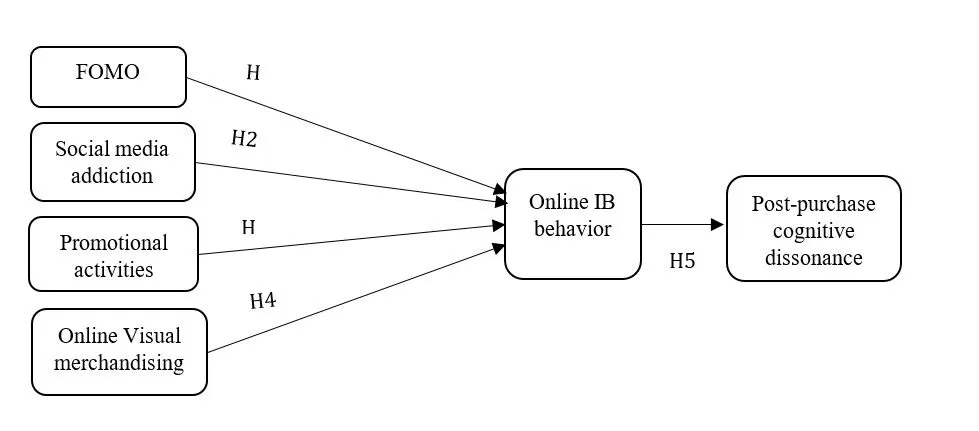
Fig. 1: Conceptual model
Source: Figure created by Authors
Research Methodology
Sample and data collection
This study used quantitative research with a survey method to achieve the desired results. Additionally, the study used a convenient sample to collect data. Convenience sampling has several advantages, such as cost-effectiveness, and ease of use (Jopp et al., 2022; Lim et al., 2022a, 2022b). Data were collected by a self-administered online questionnaire that was distributed over social media platforms such as WhatsApp, Facebook, and LinkedIn. The online survey was selected for its prompt and cost-effective geographical reach (Jaiswal et al., 2022; Upadhyay et al., 2022). Prior research has employed the survey method to gather data in comparable situations (Chetioui and El Bouzidi, 2023; Tran, 2022). According to Kaish (1967), Kotler (2001) and Chen (2011), cognitive dissonance, a form of mental discomfort, is most commonly experienced with the purchase of high-involvement items, such as shopping goods or specialty goods. Hence, a high-involvement product has been selected for this study to evaluate the research constructs. According to Pei (2013), the degree of cognitive dissonance is influenced by the significance of the decision, the appeal and availability of alternatives, and the similarities between the options. Therefore, this product can be: cell phones, laptops, iPads, compact digital cameras, small home appliances, TVs, microwaves, furniture, and fashion products (clothing, wristwatches, shoes, bags, etc.). The survey targeted Egyptian customers who shop online. Out of 347 completed questionnaires submitted, 284 replies were considered valid and acceptable. This study uses structural equation modeling (SEM) for data analysis.
Measures
Following the literature review, a self-administered survey was developed utilizing scale items derived from validated measures. Respondents evaluated their agreement or disagreement with each statement on a five-point Likert scale, ranging from one (strongly disagree) to five (strongly agree). Tab. 1 provides a clear summary of these details.
Tab. 1: Measurement scale sources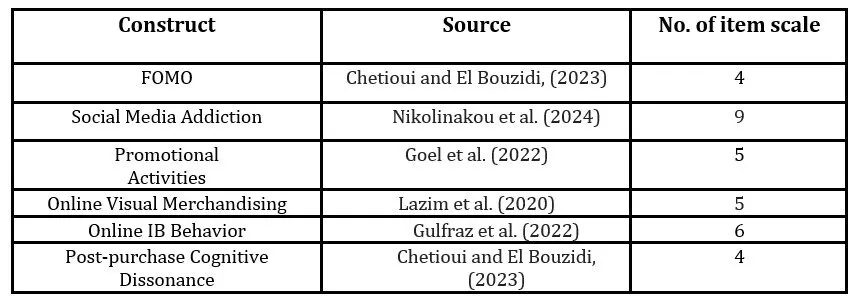
Source: Table created by Authors
Results
In accordance with the methods used in the literature (Chetioui and El Bouzidi, 2023; Goel et al., 2022), we asked respondents to indicate whether they had ever made an online purchase of shopping or specialty goods. The number of valid responses was 284. Tab. 2 displays the demographic characteristics of the sample.
Tab. 2: Demographic characteristics of the sample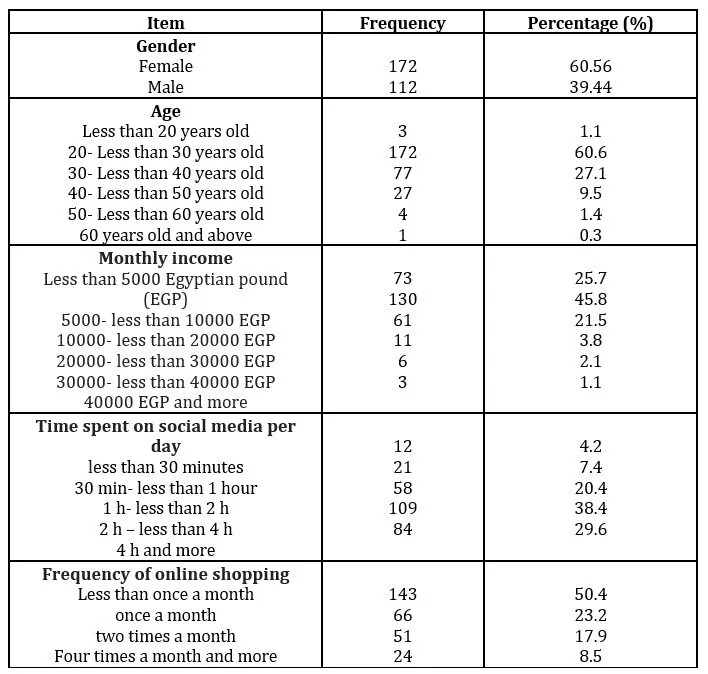
Source: Table created by Authors
This study used AMOS 24.0 confirmatory factor analysis (CFA) to look at the relationships between the latent variables. The suggested model was evaluated using structural equation modeling (SEM). Several measures were used to assess the study model’s fit: root mean squared error of approximation (RMSEA), comparative fit index (CFI), normed fit index (NFI), and Tucker-Lewis’s index (TLI). Tab. 3 displays the CFA results, which demonstrate that CFI, TLI, and NFI all exceed the stated standard (Hair et al., 1998; Hu and Bentler, 1999), with all three values exceeding 0.9, and RMSEA value is less than 0.06.
Tab. 3: The results of model fit measurements

Source: Table created by Authors
Structural equation modeling uses confirmatory factor analysis to evaluate construct validity. Campbell and Fiske (1959) established two criteria for assessing the construct validity of a test: convergent validity and discriminant validity. Composite Reliability (CR) and Average Variance Extracted (AVE) measure convergent validity. AVE value of 0.5 is deemed acceptable, while the level of 0.7 is considered very good. CR value should be 0.7 or above (Alarcón and Sánchez, 2015). Tab. 4 shows CR, AVE, and factor loading. Standardized loading for all expressions is statistically significant at a significance level below 0.01. All expression standardized loadings were larger than 0.5. Therefore, they were appropriate, with the exception of two statements that were removed (XF1 & M1) since they were less than 0.5. From tab. 4, CR indicators exceed the threshold value of 0.7 (Bagozzi, 1994), and all AVE indicators are satisfactory (equal to or above 0.5). Consequently, these values are considered acceptable. Thus, affirming the convergent validity of the scales (Bagozzi and Yi, 1988).
Tab. 4: List of measurement items, factor loading, CR, and AVE
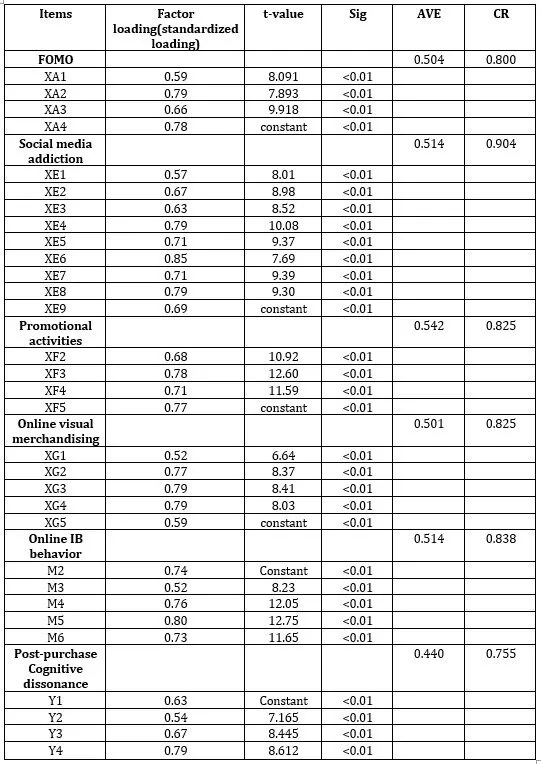
Source: Table created by Authors
The square root of the AVE of each and every construct was greater than the absolute value of the correlation between each pair of constructs, indicating an acceptable level of discriminatory validity for the variables (Gefen et al., 2000), as shown in Tab. 5. Additionally, there is a moderate correlation between the variables since the correlation coefficient among the variables is below 0.90, hence confirming discriminant validity.
Tab. 5: Discriminant validity
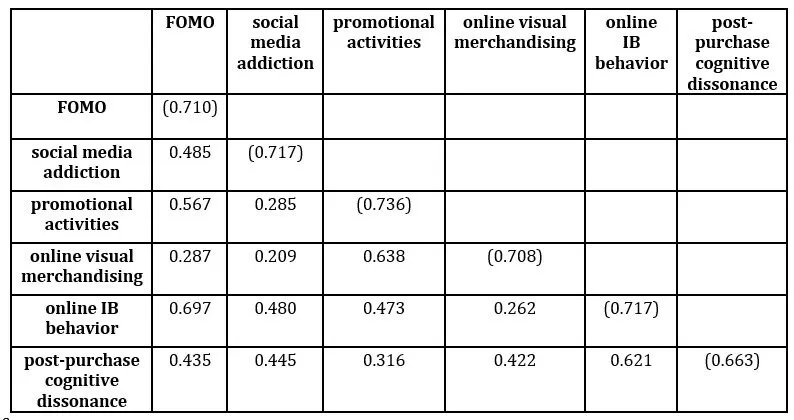 Source: Table created by Authors
Source: Table created by Authors
The following figure (see Fig.2) displays results of structure equation model. To test the study model and its hypotheses, structural equation model is used (Hair et al., 1998). The results in Tab. 6 demonstrated that FOMO has a positive significant influence on online IB behavior (β=0.542, t-values= 6.501, p< 0.05). Furthermore, online IB behavior was affected directly and significantly by social media addiction (β=0.295, t-values= 4.469, p< 0.05), and promotional activities (β=0.199, t-values= 3.178, p < 0.05). Hence, H1, H2, and H3 were supported. However, online visual merchandising had an insignificant effect on online IB behavior (β =0.039, t-values =0.647, p= 0.518). Therefore, H4 was not supported and cannot explain online IB behavior according to this study. Moreover, online IB behavior significantly and positively influenced post-purchase cognitive dissonance (β=0.591, t-values=6.404, p < 0.05), supporting H5.
Tab. 7 shows the evaluation of the coefficient of determination (R-square) of the two endogenous latent variables: online IB behavior and post-purchase cognitive dissonance. This study explains 42.2 % of online IB behavior, and 34.9 % of post-purchase cognitive dissonance value in the conceptual model. According to Chin (1998), the presented model has a moderate predictive power.
Tab. 6: Result structure equation model test
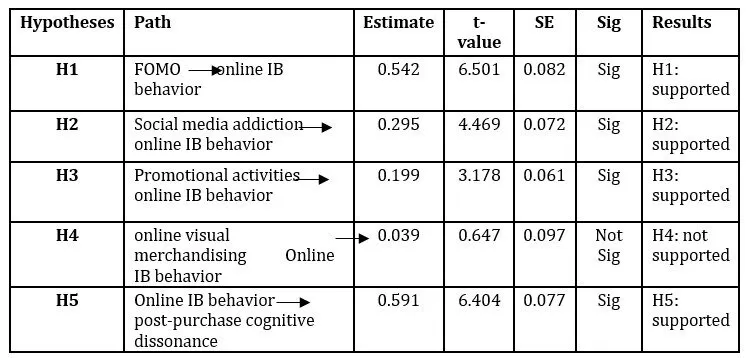
Source: Table created by Authors
Tab. 7: R-square results
 Source: Table created by Authors
Source: Table created by Authors
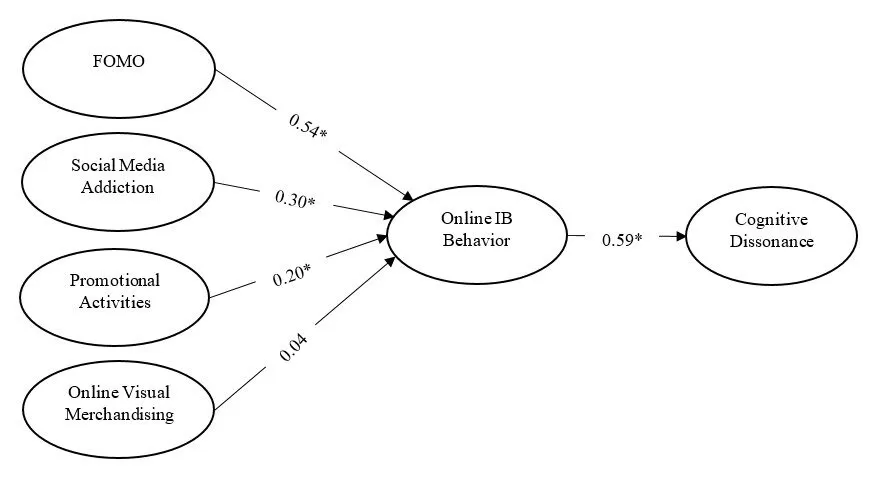
Fig. 2: Hypotheses testing of structural model
Note(s): *p< 0.05
Source: Figure created by Authors
Discussion
According to Chetioui et al. (2021), research on online shopping in emerging countries is limited. As a result, this study’s primary aim is to examine the factors that lead Egyptian consumers to make online impulsive purchases, and how those purchases affect their cognitive dissonance after purchasing. The results of this study indicated that FOMO had a positive significant impact on online IB, which is in line with the findings of prior empirical investigations (Chetioui and El Bouzidi, 2023; Good and Hyman, 2021). This indicates that consumers opt for immediate and impulsive acquisitions in an effort to align with their contemporaries. Second, H2 was supported by the fact that social media addiction has a direct, significant effect on online IB. This agrees with the findings of a prior study about online IB done by Nikolinakou et al. (2024). Consequently, the results also supported H3 by demonstrating that promotional activities are a crucial determinant of online IB, aligning with prior research conducted by Goel et al. (2022). This indicates that customers largely depend on the incentives and promotions provided by online stores when they make online purchases. However, our data indicated no substantial effect of online visual merchandising on online IB behavior. Hence, H4 was not supported, which may be attributed to the small sample size. In other words, the website’s visual appeal and product presentation were not the most important website characteristics for the Egyptian customers who participated in our study. This result is not consistent with previous findings of Le, (2018). Finally, our findings validated H5 and demonstrated that online IB behavior had a direct and significant influence on post-purchase cognitive dissonance. This is consistent with the findings of other studies (Chetioui and El Bouzidi, 2023; Simanjuntak and Pratama, 2024). According to Barta et al. (2022), customers experience post-purchase cognitive dissonance when there is no good reason for their purchase. Grigsby et al. (2020) argue that people often feel guilty and uncomfortable after making irrational purchases.
Theoretical implications
This study adds to the marketing literature with several theoretical advances. In the first place, this study examines e-commerce by looking into the phenomena of online impulsive buying in a developing nation where this idea has received less academic attention. Additionally, this study offers a clearer understanding of online impulsive buying by suggesting a combined model of internal and external factors (FOMO, social media addiction, promotional activities, and online visual merchandising) related to this behavior. Moreover, the study findings provide profound insights into customers’ post-purchase feelings after impulsive purchases, which may benefit both scholars and practitioners, particularly in light of the considerable expansion of global e-commerce. Lastly, this study found a substantial relationship between online IB behavior and post-purchase cognitive dissonance. Hence, facilitating further investigation into additional factors influencing post-purchase cognitive dissonance.
Practical Implications
Marketing managers are likely to benefit in a number of different ways from the findings of the current research. First, our findings indicate that FOMO is a primary factor influencing online IB behavior. Online businesses can enhance the appeal of their products to evoke emotions of FOMO, which in turn encourage shoppers to make hasty purchases. In addition, the increasing competition among online businesses enables customers to select those online stores that offer advantages. Consequently, online stores need to plan ahead by considering what kinds of product promotions they can run. In addition to using coupons and cash discounts, marketers may offer supplemental items and services as a way to entice customers. Based on the study findings, online stores must recognize the significance of website efficacy in influencing consumers’ decisions regarding online purchases. This can be achieved not only by improving the visual aesthetics of websites but also by strengthening their navigability, interactivity, usability, and ensuring that websites are secure for financial transactions. When e-commerce websites enhance their interactive design and functionality, users are more inclined to make actual transactions.
Furthermore, the study findings indicate that online IB affects cognitive dissonance among consumers. Ebeid and Gadelrab (2014) proposed that retailers should utilize their websites to execute marketing efforts aimed at alleviating the negative perceptions consumers hold towards sellers. Moreover, online stores can utilize this to develop aesthetically pleasing e-commerce platforms and efficient digital marketing strategies to mitigate adverse emotions linked to online IB behavior, which may affect the likelihood of future purchases on the same platform. Mitigating such unpleasant sentiments, some individuals may feel upon receiving a product, can be addressed early by implementing incentives such as coupons for further purchases, providing timely information delivery in the event of any inquiries, and return policies may be evaluated to increase flexibility. This study shows that excessive and detrimental social media activity might cause social media buying. Social media addiction can harm one’s well-being (Frost and Rickwood, 2017; Marino et al., 2018), and lead to excessive consumption (Pahlevan and Yeoh, 2018). Therefore, users should take precautions to avoid it. Social media businesses and advertisers should work together to identify users exhibiting addiction to social media platforms, utilizing their usage patterns, and implement self-regulation initiatives that restrict excessive exposure to advertising content, for instance, through tailored content that highlights the adverse effects of social media addiction.
Limitations and future research
The current study has a number of limitations. First, it is important to exercise caution when generalizing the results because our study was limited by a convenience sample. Furthermore, the research relied on cross-sectional data. A longitudinal study would be perfect because psychological aspects of individuals may change over time. Third, the study only included participants from Egypt. Accordingly, future studies could benefit from obtaining data from other countries to investigate the hypothesized relationships of this study. Fourth, the study concentrated on particular factors to examine the antecedents of online IB. Consequently, additional factors may influence consumer engagement in impulsive purchasing, such as self-congruence and materialism. Finally, future research may consider the role of personality traits and demographic variables (gender, age, income, and education) as moderators to investigate the hypothesized relationships of this study.
Conclusion
This study investigated the internal and external drivers of online impulsive buying behavior and its impact on post-purchase cognitive dissonance among Egyptian consumers. The findings confirmed that fear of missing out (FOMO), social media addiction, and promotional activities significantly influence impulsive buying behavior. However, online visual merchandising did not show a significant impact. Furthermore, the study highlighted a strong positive relationship between online impulsive buying and post-purchase cognitive dissonance, emphasizing the psychological distress that follows unplanned online purchases. These findings provide valuable insights for marketers aiming to enhance their online sales strategies while addressing consumer post-purchase concerns. Online stores can leverage FOMO-driven marketing tactics, optimize promotional campaigns, and develop customer engagement strategies to encourage impulse purchases. However, they should also implement measures to reduce cognitive dissonance, such as transparent return policies, personalized post-purchase communication, and enhanced product information to ensure customer satisfaction.
References
- Abel, J. P., Buff, C. L. and Burr, S. A. (2016), ‘Social media and the fear of missing out: Scale development and assessment,’ Journal of Business & Economics Research, 14(1), 33-44.
- Akram, U., Hui, P., Khan, M. K., Tanveer, Y., Mehmood, K. and Ahmad, W. (2018), ‘How website quality affects online impulse buying: Moderating effects of sales promotion and credit card use,’Asia Pacific Journal of Marketing and Logistics, 30(1), 235-256.
- Alarcón, D., Sánchez, J. A. and De Olavide, U. (2015, October), ‘Assessing convergent and discriminant validity in the ADHD-R IV rating scale: User-written commands for Average Variance Extracted (AVE), Composite Reliability (CR), and Heterotrait-Monotrait ratio of correlations (HTMT),’ In Spanish STATA meeting,39, 1-39.
- Badgaiyan, A. J., Verma, A. and Dixit, S. (2016), ‘Impulsive buying tendency: Measuring important relationships with a new perspective and an indigenous scale,’IIMB Management Review, 28(4), 186-199.
- Bagozzi, R. P. (1994), ‘Effects of arousal on organization of positive and negative affect and cognitions: Application to attitude theory,’Structural Equation Modeling: A Multidisciplinary Journal, 1(3), 222-252.
- Bagozzi, R. P. and Yi, Y. (1988), ‘On the evaluation of structural equation models,’Journal of the academy of marketing science, 16, 74-94.
- Barta, S., Gurrea, R. and Flavián, C. (2022), ‘The role of flow consciousness in consumer regret,’ Internet Research, 32(3), 875-896.
- Bastow-Shoop, H. E., Zetocha, D. F. and Passewitz, G. (1991), ‘Visual merchandising: A guide for small retailers,’ North Central Regional Center for Rural Development, Iowa State University of Science and Technology.
- Campbell, D. T. and Fiske, D. W. (1959), ‘Convergent and discriminant validation by the multitrait-multimethod matrix,’ Psychological bulletin, 56(2), 81-105.
- Cavazos-Arroyo, J. and Máynez-Guaderrama, A. I. (2022), ‘Antecedents of online impulse buying: An analysis of gender and centennials’ and millennials’ perspectives,’Journal of theoretical and applied electronic commerce research, 17(1), 122-137.
- Chan, T. K., Cheung, C. M. and Lee, Z. W. (2017), ‘The state of online impulse-buying research: A literature analysis,’ Information & Management, 54(2), 204-217.
- Chen, T. Y. (2011), ‘Optimistic and pessimistic decision making with dissonance reduction using interval-valued fuzzy sets,’ Information Sciences, 181(3), 479-502.
- Chen, W. K., Chen, C. W. and Lin, Y. C. (2023), ‘Understanding the influence of impulse buying toward consumers’ post-purchase dissonance and return intention: an empirical investigation of apparel websites,’Journal of Ambient Intelligence and Humanized Computing, 14, 1-14.
- Chetioui, Y. and El Bouzidi, L. (2023), ‘An investigation of the nexus between online impulsive buying and cognitive dissonance among gen Z shoppers: are female shoppers different? ,’Young Consumers, 24(4), 406-426.
- Chetioui, Y., Lebdaoui, H. and Chetioui, H. (2021), ‘Factors influencing consumer attitudes toward online shopping: the mediating effect of trust,’ EuroMed Journal of Business, 16(4), 544-563.
- Chin, W. W. (1998), ‘The partial least squares approach to structural equation modeling,’ Modern methods for business research/Lawrence Erlbaum Associates.
- Cummings, W. H. and Venkatesan, M. (1976), ‘Cognitive dissonance and consumer behavior: A review of the evidence,’Journal of Marketing Research, 13(3), 303-308.
- Dawson, S. and Kim, M. (2010), ‘Cues on apparel web sites that trigger impulse purchases,’Journal of Fashion Marketing and Management: An International Journal, 14(2), 230-246.
- Dutta, T. and Mandal, M. (2018), Neuromarketing in India: Understanding the Indian Consumer, 1st ed. Routledge, Abingdon, Oxfordshire.
- Ebeid, A. Y. and Gadelrab, H. F. (2014), ‘A structural equation modeling approach to investigate negative word of mouth impact on Customer-Based brand equity: does attribution matter? ,’International Journal of Business and Social Research, 4(9), 1-13.
- Elhai, J. D., Levine, J. C., Dvorak, R. D. and Hall, B. J. (2016), ‘Fear of missing out, need for touch, anxiety and depression are related to problematic smartphone use,’Computers in Human Behavior, 63, 509-516.
- Elliot, A.J. and Devine, P.G. (1994), ‘On the motivational nature of cognitive dissonance: dissonance as psychological discomfort,’ Journal of Personality and Social Psychology, 67(3), 382-394.
- Festinger, L. (1957), A theory of cognitive dissonance. Evanstone, IL: Row, Peterson.
- Frost, R. L. and Rickwood, D. J. (2017), ‘A systematic review of the mental health outcomes associated with Facebook use,’Computers in Human Behavior, 76, 576-600.
- Gabler, C.B., Landers, V.M. and Reynolds, K.E. (2017), ‘Purchase decision regret: negative consequences of the steadily increasing discount strategy,’ Journal of Business Research, 76, 201-208.
- Gefen, D., Straub, D. and Boudreau, M. C. (2000), ‘Structural Equation Modeling and Regression: Guidelines for Research Practice,’ Communications of the Association for Information Systems, 4 (1), 7.
- George, B. P. and Yaoyuneyong, G. (2010), ‘Impulse buying and cognitive dissonance: a study conducted among the spring break student shoppers,’Young Consumers, 11(4), 291-306.
- Goel, P., Parayitam, S., Sharma, A., Rana, N. P. and Dwivedi, Y. K. (2022), ‘A moderated mediation model for e-impulse buying tendency, customer satisfaction and intention to continue e-shopping,’ Journal of Business Research, 142, 1-16.
- Good, M.C. and Hyman, M.R. (2020), ‘Fear of missing out’: antecedents and influence on purchase likelihood,’ Journal of Marketing Theory and Practice, 28(3), 330-341.
- Good, M.C. and Hyman, M.R. (2021), ‘Direct and indirect effects of fear-of-missing-out appeals on purchase likelihood,’ Journal of Consumer Behaviour, 20(3), 564-576.
- Gordon-Hecker, T., Pittarello, A., Shalvi, S. and Roskes, M. (2020), ‘Buy-one-get-one-free deals attract more attention than percentage deals,’Journal of Business Research, 111, 128-134.
- Grigsby, J.L., Jewell, R.D. and Campbell, C. (2020), ‘Have your cake and eat it too: how invoking post purchase hyperopia mitigates impulse purchase regret,’ Marketing Letters, 32(1), 75-89.
- Gulfraz, M. B., Sufyan, M., Mustak, M., Salminen, J. and Srivastava, D. K. (2022), ‘Understanding the impact of online customers’ shopping experience on online impulsive buying: A study on two leading E-commerce platforms,’ Journal of Retailing and Consumer Services, 68, 103000.
- Ha, Y., Kwon, W. S. and Lennon, S. J. (2007), ‘Online visual merchandising (VMD) of apparel web sites,’Journal of Fashion Marketing and Management: An International Journal, 11(4), 477-493.
- Hair, J. F., Anderson, R. E., Tatham, R. L. and Black, W.C. (1998), Multivariate Data Analysis. 5th ed. Upper Saddle River, NJ: Prentice Hall.
- Hasim, M. A., Shamsudin, M. F., Ali, A. M. and Shabi, S. (2018), ‘The relationship between sales promotions and online impulse buying in Malaysia,’ Opcion, 34(16), 295–308.
- Haugh, L. J. (1983), ‘Defining and redefining,’Advertising Age, 14(2), 44.
- Hodkinson, C. (2016), ‘Fear of missing out’ (FOMO) marketing appeals: a conceptual model,’ Journal of Marketing Communications, 25(1), 1-24, doi:10.1080/13527266.2016.1234504.
- Hodkinson, C. (2019), ‘Fear of missing out’ (FOMO) marketing appeals: a conceptual model,’ Journal of Marketing Communications, 25(1), 65-88.
- Hu, L. T. and Bentler, P. M. (1999), ‘Cutoff criteria for fit indexes in covariance structure analysis: Conventional criteria versus new alternatives,’Structural equation modeling: a multidisciplinary journal, 6(1), 1-55.
- Husain, R., Ahmad, A. and Khan, B.M. (2022), ‘The role of status consumption and brand equity: a comparative study of the marketing of Indian luxury brands by traditional and social-media,’ Global Business and Organizational Excellence, 41(4), 48-67
- Imam, F. (2013), ‘Gender differences in impulsive buying behavior and post-purchasing dissonance under incentive conditions,’ Journal of business strategies, 7(1), 23-29.
- Iyer, G. R., Blut, M., Xiao, S. H. and Grewal, D. (2020), ‘Impulse buying: a meta-analytic review,’Journal of the academy of marketing science, 48(3), 384-404.
- Jaiswal, D., Deshmukh, A.K. and Thaichon, P. (2022), ‘Who will adopt electric vehicles? Segmenting and exemplifying potential buyer heterogeneity and forthcoming research,’ Journal of Retailing and Consumer Services, 67, 102969.
- Jopp, R., Kalantari, H., Lim, W.M., Wee, L.L.M. and Lim, A.L. (2022), ‘Tourist segments of eco-cultural destinations,’ Current Issues in Tourism, 25(14), 2253-2268.
- Kaish, S. (1967), ‘Cognitive dissonance and the classification of consumer goods,’ Journal of marketing, 31(4), 28-31.
- Kotler, P. (2001), Marketing Management, Millennium Edition, 10th ed., Prentice Hall, Upper Saddle River, NJ.
- Kumar, S., Lim, W.M., Pandey, N. and Christopher Westland, J. (2021), ‘20 Years of electronic commerce research,’ Electronic Commerce Research, 21(1), 1-40.
- Lake, A.L. (2009), Consumer Behavior for Dummies, Wiley Publishing Inc, Hoboken, NJ.
- Lavuri, R. and Thaichon, P. (2023), ‘Do extrinsic factors encourage shoppers’ compulsive buying? Store environment and product characteristics,’ Marketing Intelligence and Planning, 41(6), 722-740.
- Lazim, N. A. M., Sulaiman, Z., Zakuan, N., Mas’od, A., Chin, T. A. and Awang, S. R. (2020, March). ‘Measuring post-purchase regret and impulse buying in online shopping experience from cognitive dissonance theory perspective,’ In 2020 6th International Conference on Information Management (ICIM), ISBN:978-1-7281-5771-9,27-29 March 2020, London, UK, 7-13, IEEE.
- Le, P. (2018). The Influence of Online Visual Merchandising on Impulse Purchasing.
- Lim, S.H., Lee, S. and Kim, D.J. (2017), ‘Is online consumers’ impulsive buying beneficial for e-commerce companies? An empirical investigation of online consumers’ past impulsive buying behaviors,’ Information Systems Management, 34(1), 85-100.
- Lim, W.M., Aggarwal, A. and Dandotiya, R. (2022a), ‘Marketing luxury services beyond affluence in the new normal: insights from fine dining during the coronavirus pandemic,’ Journal of Retailing and Consumer Services, 66, 102936.
- Lim, W.M., Kumar, S., Pandey, N., Verma, D. and Kumar, D. (2022b), ‘Evolution and trends in consumer behaviour: insights from Journal of Consumer Behaviour,’ Journal of Consumer Behaviour, 22(1), 217-232.
- Lin, C. T., Chen, C. W., Wang, S. J. and Lin, C. C. (2023), ‘The influence of impulse buying toward consumer loyalty in online shopping: a regulatory focus theory perspective,’ Journal of Ambient Intelligence and Humanized Computing, 14, 1-11.
- Liu, P., He, J. and Li, A. (2019), ‘Upward social comparison on social network sites and impulse buying: A moderated mediation model of negative effect and rumination,’ Computers in Human Behavior, 96(1), 133–140.
- Liu, Y., Li, H. and Hu, F. (2013), ‘Website attributes in urging online impulse purchase: An empirical investigation on consumer perceptions,’ Decision Support Systems, 55(3), 829–837.
- Longdong, E.Y.E. and Pangemanan, S.S. (2015), ‘Analyzing the effect of virtual atmospheric cues, sales promotions, and situational factors on online impulse buying in MANADO,’Jurnal EMBA: Jurnal Riset Ekonomi, Manajemen, Bisnis dan Akuntansi, 3(3), 119-129.
- Luo, H., Cheng, S., Zhou, W., Song, W., Yu, S. and Lin, X. (2021), ‘Research on the Impact of Online Promotions on Consumers’ Impulsive Online Shopping Intentions,’ Journal of Theoretical and Applied Electronic Commerce Research, 16(6), 2386–2404.
- Luo, Y., Eickhoff, S.B., Hetu, S., and Feng, C. (2018), ‘Social comparison in the brain: a coordinate-based meta-analysis of functional brain imaging studies on the downward and upward comparisons,’ Human brain mapping, 39 (1), 440–458.
- Marino, C., Gini, G., Vieno, A. and Spada, M. M. (2018), ‘The associations between problematic Facebook use, psychological distress and well-being among adolescents and young adults: A systematic review and meta-analysis,’ Journal of Affective Disorders, 226, 274–281.
- Mundel, J., Wan, A. and Yang, J. (2023), ‘Processes underlying social comparison with influencers and subsequent impulsive buying: The roles of social anxiety and social media addiction,’Journal of Marketing Communications, 30(7), 834-851.
- Muruganantham, G. and Bhakat, R.S. (2013), ‘A review of impulse buying behavior,’ International Journal of Marketing Studies, 5(3), 149-160.
- Naeem, M. (2021), ‘Understanding the customer psychology of impulse buying during COVID-19 pandemic: implications for retailers,’ International Journal of Retail & Distribution Management, 49(3), 377-393.
- Nikolinakou, A., Phua, J. and Kwon, E. S. (2024), ‘What drives addiction on social media sites? The relationships between psychological well-being states, social media addiction, brand addiction and impulse buying on social media,’ Computers in Human Behavior, 153, 108086.
- Pahlevan Sharif, S. and Yeoh, K. K. (2018), ‘Excessive social networking sites use and online compulsive buying in young adults: the mediating role of money attitude,’ Young Consumers, 19(3), 310-327.
- Park, J.E. and Yoon, S.-J. (2017), ‘Antecedents of consumer animosity and the role of product involvement on purchase intentions,’ American Journal of Business, 32(1), 42-57.
- Parsad, C., Prashar, S., Vijay, T.S. and Kumar, M. (2021), ‘Do promotion and prevention focus influence impulse buying: the role of mood regulation, shopping values, and impulse buying tendency,’ Journal of Retailing and Consumer Services, 61(1), 102554.
- Pei, Z. (2013), ‘Rational decision making models with incomplete weight information for production line assessment,’ Information Science, 222(10), 696-716.
- Przybylski, A. K., Murayama, K., DeHaan, C. R. and Gladwell, V. (2013), ‘Motivational, emotional, and behavioral correlates of fear of missing out,’ Computers in Human Behavior, 29(4), 1841–1848.
- Robbins, S.P. and Judge, T.A. (2009), Organizational Behavior, 13th ed., Pearson, Prentice Hall, Upper Saddle River, NJ.
- Rook, D. W. (1987), ‘The buying impulse,’Journal of consumer research, 14(2), 189-199.
- Saini, C., Gupta, R. and Khurana, I. (2015), ‘Visual Merchandising and Impulse Buying Behavior: A Case of Retail Industry,’International Journal of Advance Research in Science & Engineering, 4(2), 621-627.
- Sameeni, M., Ahmad, W. and Filieri, R. (2022), ‘Brand betrayal, post-purchase regret, and consumer responses to hedonic versus utilitarian products: the moderating role of betrayal discovery mode,’ Journal of Business Research, 141, 137-150.
- Sarwar, M. A., Nasir, J., Sarwar, B., Hussain, M. and Abbas, A. (2024), ‘An investigation of precursors of online impulse buying and its effects on purchase regret: role of consumer innovation,’ International Journal of Innovation Science, 16(5), 877-894.
- Serfas, B.G., Büttner, O.B. and Florack, A. (2014), ‘Eyes wide shopped: shopping situations trigger arousal in ımpulsive buyers,’ PLOS ONE, 9(12), 1–9.
- Shaffer, H. J., LaPlante, D. A., LaBrie, R. A., Kidman, R. C., Donato, A. N. and Stanton, M. V. (2004), ‘Toward a syndrome model of addiction: Multiple expressions, common etiology,’ Harvard Review of Psychiatry, 12(6), 367–374.
- Simanjuntak, E. R. and Pratama, R. S. (2024), ‘IT affordances, flow, and perceived scarcity: A study on impulsive buying behavior and post-purchase dissonance in live shopping,’ Journal The Winners, 25(1), 13-23.
- Singh, P., Sharma, B. K., Arora, L. and Bhatt, V. (2023), ‘Measuring social media impact on Impulse Buying Behavior,’ Cogent Business & Management, 10(3), 2262371.
- Stern, H. (1962), ‘The significance of impulse buying today,’ Journal of Marketing, 26(2), 59-62.
- Tran, V. D. (2022), ‘Consumer impulse buying behavior: the role of confidence as moderating effect,’ Heliyon, 8(6), e09672.
- Upadhyay, N., Upadhyay, S., Abed, S.S. and Dwivedi, Y.K. (2022), ‘Consumer adoption of mobile payment services during COVID-19: extending meta-UTAUT with perceived severity and self-efficacy,’ International Journal of Bank Marketing, 40(5), 960-991.
- Verma, H. and Singh, S. (2019), ‘An exploration of e-impulse buying,’International Journal of Electronic Marketing and Retailing, 10(1), 45–59.
- Wells, J. D., Parboteeah, V. and Valacich, J. S. (2011), ‘Online impulse buying: Understanding the interplay between consumer impulsive ness and website quality,’ Journal of the Association for Information Systems, 12(1), 32–56.
- Wood M (1998), ‘Socio-economic status, delay of gratification, and impulse buying,’ Journal of economic psychology, 19(3), 295–320.
- Yoon, F. and Faber, R.J. (2000), ‘Impulse Buying: Its Relation to Personality Traits and Cues,’ UT: Association Consumer Research, 27, 179–185.
- Zhao, Y., Li, Y., Wang, N., Zhou, R. and Luo, X. (2022), ‘A meta-analysis of online impulsive buying and the moderating effect of economic development level,’Information Systems Frontiers, 24(5), 1667-1688.











